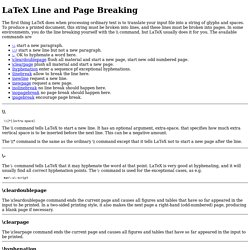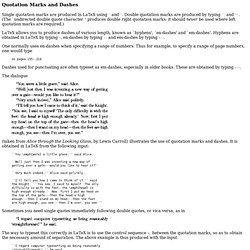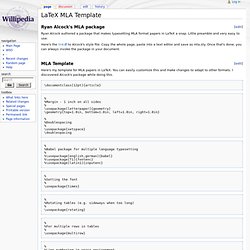

LaTeX Line and Page Breaking. The first thing LaTeX does when processing ordinary text is to translate your input file into a string of glyphs and spaces.

To produce a printed document, this string must be broken into lines, and these lines must be broken into pages. In some environments, you do the line breaking yourself with the \\ command, but LaTeX usually does it for you. The available commands are \\ start a new paragraph. \\* start a new line but not a new paragraph. \- OK to hyphenate a word here. \cleardoublepage flush all material and start a new page, start new odd numbered page. \clearpage plush all material and start a new page. \\[*][extra-space] The \\ command tells LaTeX to start a new line. The \\* command is the same as the ordinary \\ command except that it tells LaTeX not to start a new page after the line. The \- command tells LaTeX that it may hyphenate the word at that point. Man\-u\-script \cleardoublepage \clearpage \hyphenation \hyphenation{words} \linebreak \linebreak[number]
Quotation Marks and Dashes. Quotation Marks and Dashes Single quotation marks are produced in LaTeX using ` and '.

Double quotation marks are produced by typing `` and ''. (The `undirected double quote character " produces double right quotation marks: it should never be used where left quotation marks are required.) LaTeX allows you to produce dashes of various length, known as `hyphens', `en-dashes' and `em-dashes'. Hyphens are obtained in LaTeX by typing -, en-dashes by typing -- and em-dashes by typing ---. One normally uses en-dashes when specifying a range of numbers. On pages 155--219. LaTeX MLA Template - Willipedia. [edit] Ryan Alcock's MLA package Ryan Alcock authored a package that makes typesetting MLA format papers in LaTeX a snap.

Little preamble and very easy to use. Here's the link to Alcock's style file. Copy the whole page, paste into a text editor and save as mla.sty. Once that's done, you can always invoke the package in your document. [edit] MLA Template Here's my template for MLA papers in LaTeX. \documentclass[12pt]{article} % %Margin - 1 inch on all sides % \usepackage[letterpaper]{geometry} \geometry{top=1.0in, bottom=1.0in, left=1.0in, right=1.0in} % %Doublespacing % \usepackage{setspace} \doublespacing % %Babel package for multiple language typesetting % %\usepackage[english,german]{babel} %\usepackage[T1]{fontenc} %\usepackage[latin1]{inputenc} % %Setting the font % \usepackage{times} % %Rotating tables (e.g. sideways when too long) % \usepackage{rotating} % %For multiple rows in tables % \usepackage{multirow} % %Begin document % \begin{document} \begin{flushleft} \end{workscited} Fonts - Simplest way to typeset entire document in sans serif (Helvetica)
Math mode - Typeset mathematical symbols also in sans serif font? LaTeX. This is a guide to the LaTeX markup language.

It is intended to form a useful resource for everybody from new users who wish to learn, to old hands who need a quick reference. TeX and LaTeX TeX is a computer program for typesetting documents, created by Donald Knuth. It takes a suitably prepared computer file and converts it to a form which may be printed on many kinds of printers, including dot-matrix printers, laser printers and high-resolution typesetting machines. LaTeX is a set of macros for TeX that aims at reducing the user's task to the sole role of writing the content, LaTeX taking care of all the formatting process. The book is organized in different parts.
Getting Started will provide you with the very first steps to print your first document: general concepts (very important!) Contents[edit] If you have questions related to LaTeX, ask at the Q&A. Edit the TOC or the stages Other wikibooks[edit] LaTeX Tutorials (featuring Texmaker)